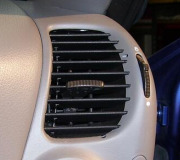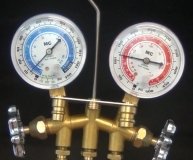I like to pry the pistons in with a flat blade screwdriver before I unbolt the calipers. If they don't go in that way, there is a restriction in the hydraulic system or the pistons are sticking. Open the bleeder screw. If the piston goes in now, the hose could be constricted or the brake fluid is contaminated with petroleum product.
Hose constriction is more common on Chrysler products that use a metal anchor bracket in the middle of the rubber hose. Rust buildup inside where that bracket is crimped around the hose pinches it off. The brake will apply with heavy pedal pressure but will take a long time to release, (potentially hours). The pedal will be higher and harder than normal too. The fix is real easy and just involves using a large pliers to open the crimp a little. Another hint is the brake won't release when cracking open the line at the master cylinder.
If the piston will pry back after cracking the steel line at the master cylinder, fluid contamination should be suspected. Petroleum products, such as power steering fluid, engine oil, and transmission fluid causes rubber parts to swell. The clue is the bladder seal under the reservoir cap will be greatly expanded and mushy. The lip seals in the master cylinder also grow past the return ports and trap the fluid. As the brakes heat up, the heat transfers into the fluid which expands and since it can't flow back into the reservoir, it applies the brakes harder.
On Fords, it's more common to simply have rust pits or dirt on the pistons causing them to stick. You will not be able to pry them back even with the bleeder screw open. The c-clamp will get the piston to go in, but that rust or dirt will be under the square-cut seal. The way the seal is supposed to work is it tends to stick to the piston when fluid pushes the piston out to apply the brake. By sticking to it, it deforms or bends a little. When you release the pedal, the seal wants to straighten out. That's what pulls the piston in just enough to release pressure on the pads. As the pads wear down, the piston moves out a little further. The seal can only bend so far, so the piston slides a little through it. That's how it self-adjusts. When dirt or rust is on the piston, it will stick applied and refuse to release.
As for screwing the pistons in, that only applies to GMs and Fords with the parking brake built into the rear calipers. Once they are screwed in and the pads are installed, they will only come out by applying the parking brake. Regular use of the parking brake is required to keep the rear calipers in adjustment. Chryslers have always used a drum parking brake inside the rotors when the rear uses disc brakes. Some newer Fords are going that way too. It is a much simpler and more reliable design.
Caradiodoc
Saturday, April 25th, 2020 AT 5:43 PM
(Merged)



